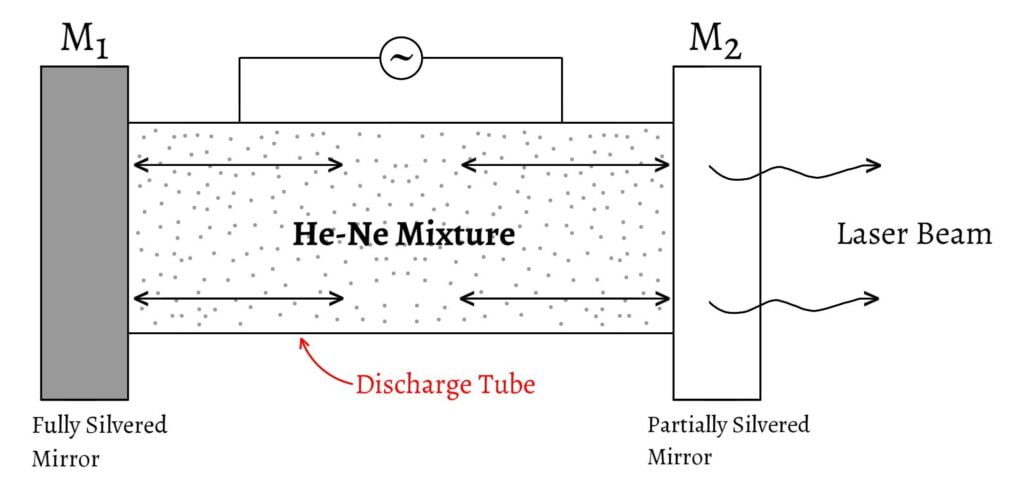Helium-Neon laser is a gas type laser and a four level laser. In He-Ne laser, population inversion is achieved in a different way from the three level Ruby laser.
Construction of Helium-Neon Laser
He-Ne laser consists of a discharged glass tube about 0.5 m long and 5 mm in diameter. It contains a mixture of helium and neon in the ratio 10:1 at a low temperature (~1 mm of Hg). It has two mirrors M1 and M2 at both ends. The mirror M1 is fully silvered and another mirror M2 is partially silvered. The spacing between the mirrors is equal to an integral number of half-wavelength of the laser light. An electric discharge is produced in the gas by electrodes outside the tube connected to a source of high frequency alternating current.

Working Principle of Helium-Neon Laser
The discharged electrons collide and excite (pump) the He and Ne atoms to metastable state 20.61 eV and 20.66 eV respectively above their ground states. Some of the excited He atoms transfer their energy to ground state Ne atoms by colliding, with 0.05 eV of additional energy (20.66-20.61=0.05 eV) being provided by the kinetic energy of the atoms. Thus, the purpose of the He atoms is to achieve a population inversion in the Ne atoms.

When an excited Ne atom drops from the metastable state at 20.66 eV to an excited state at 18.70 eV, it emits a photon of wavelength 6328Å which travels through the mixture and if it is moving parallel to the axis of the tube, then it is reflected back and forth between the mirrors placed at ends of the tube until it stimulates an excited Ne atom and cause it to emit a fresh photon of wavelength 6328Å in phase with the stimulating photon. This stimulated transition from 20.66 eV to 18.70 eV level is the laser transition. This process of amplification continues till a quite coherent, parallel and intense monochromatic beam is developed which emerges out from the partly silvered mirror and it is the laser beam.
When the excited Ne atom passes down from the 18.70 eV level to the lower metastable state, another photon is spontaneously emitted which give only incoherent light and finally Ne atom comes to the ground state through collision with the tube walls and excitation energy is lost in the collision and thus the final transition is radiation less.
Clearly, the Ne atom in its ground state cannot absorb the 6328 Å photons from the laser beam, as it happens in the three level Ruby laser. He-Ne laser also operates continuosly because the electron impacts that excite the He and Ne atoms occur all the time.
Advantages of He-Ne Laser
- It emits laser light in the visible portion of the spectrum.
- It has high stability.
- It has low cost.
- It operates without damage at high temperatures.
Disadvantages of He-Ne Laser
- It has low efficiency.
- It has low gain.
